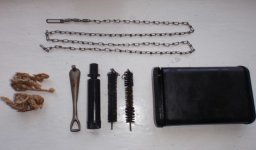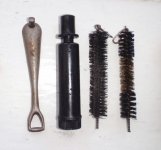
You are using an out of date browser. It may not display this or other websites correctly.
You should upgrade or use an alternative browser.
You should upgrade or use an alternative browser.
Mundlos "ab" Rg34 Tool Incongruites
- Thread starter pwcosol
- Start date
Dot:
Excellent submissions ! Also thanks to Mrfarb we now have a RG34 HKW "sticky" where links to in-depth discussions about them can be readily referenced. This helps immensely. Although I only have about 45 kits, over time some were traded, sold, or upgraded, etc. I keep a written description of each kit & it's contents, but that is very general. I definitely need to go thru them all sometime soon and in particular evaluate the HKW in each one. The sticky will make that a much easier task (with the unattributed examples in particular)...
Excellent submissions ! Also thanks to Mrfarb we now have a RG34 HKW "sticky" where links to in-depth discussions about them can be readily referenced. This helps immensely. Although I only have about 45 kits, over time some were traded, sold, or upgraded, etc. I keep a written description of each kit & it's contents, but that is very general. I definitely need to go thru them all sometime soon and in particular evaluate the HKW in each one. The sticky will make that a much easier task (with the unattributed examples in particular)...
I’m guessing the postwar tools were made by the G.Appel company.
I don't think so.
Have two undated post war G.Appel kits. Both are in nearly new condition, but came with no HKW. I assume they were produced in the early 1960s, when the West German Army did not have use for the HKW anymore.
So far, I did not run across a dated post war G.Appel cleaning kit, or one with the HKW.
Thanks
Here some photos of two postwar East German "Bakelite" cleaning kits showing the contents. Note the same tool variant, one in white and the other blued.
Images taken from the web.
Antoni
Did you ever find an East German cleaning kit with the aluminum oiler?
From my observations, the aluminum oilers only show up with reissued WWII cleaning kits.
Thanks
Wolfgang
dot
Senior Member
Did you ever find an East German cleaning kit with the aluminum oiler?
From my observations, the aluminum oilers only show up with reissued WWII cleaning kits.
Thanks
Wolfgang
Wolfgang, I have a complete ab44 (without Waffenamt) kit, which I assume is from East Germany, with the aluminium oiler inside. In my opinion this type of oiler was post war manufactured.
Antoni
Did you ever find an East German cleaning kit with the aluminum oiler? From my observations, the aluminum oilers only show up with reissued WWII cleaning kits.
Have found several of the aluminum oilers within the "apple green" repainted kits that were repurposed for post-war issue. The oilers appear tp be injection molded? Quite a number of those kits have been observed with the rco45 marking. Perhaps unused old stock cans that were pressed into service. Agree with Antoni that these oil bottles are post war.
Have found several of the aluminum oilers within the "apple green" repainted kits that were repurposed for post-war issue.
That is what I wanted to point out. They only show up in reissued WWII kits, but never with the post war plastic/bakelite kits.
That is what I wanted to point out. They only show up in reissued WWII kits, but never with the post war plastic/bakelite kits.
You are spot-on Wolfgang. As you were when you first identified the aluminum oilers as post war several years ago. The plastic/bakelite kits seem to universally come with post war phenolic/plastic oil bottles.
Frysk
Member
Hello, a question: is this a original spoon?
Recently got this Mundlos 1940 spoon(above).
It is not the typical pre/early/mid war construction you would expect from this timeframe.
See pictures for reference.


Laying this one besides the mid/late war spoons i have, it doesn’t match any spoon besides one spare i have(no idea how i got that one).
While it does look closely to hawig spoons, the way the pin is mounted on the back of the spoon doesn’t match with any others laying around. A quick look on Anthoni’s site didn’t give me an answer.
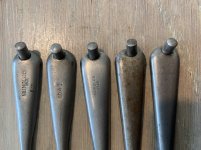
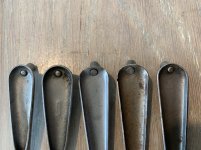
The one on the right i believe is a Hawig made spoon.
The second right and the middle one being the ones i’m not sure about, the are identical while having small differences with the one on the right.
I only have one late tool in a Mundlos kit but that one is identical to the hawig spoon, so no comparing with that one.
Hope i’m clear on what i’m trying to explain..
Kind regards
Recently got this Mundlos 1940 spoon(above).
It is not the typical pre/early/mid war construction you would expect from this timeframe.
See pictures for reference.


Laying this one besides the mid/late war spoons i have, it doesn’t match any spoon besides one spare i have(no idea how i got that one).
While it does look closely to hawig spoons, the way the pin is mounted on the back of the spoon doesn’t match with any others laying around. A quick look on Anthoni’s site didn’t give me an answer.


The one on the right i believe is a Hawig made spoon.
The second right and the middle one being the ones i’m not sure about, the are identical while having small differences with the one on the right.
I only have one late tool in a Mundlos kit but that one is identical to the hawig spoon, so no comparing with that one.
Hope i’m clear on what i’m trying to explain..
Kind regards
Last edited:
My concerns are primarily twofold regarding the MUNDLOS | 1940 HKW in question. First, it has no serrations on the front end of the patch holder. Second, the later, simplified stamping of the HKW is seen probably no earlier than late 1942 (if at all in that year). Lastly, the MUNDLOS | 1940 stamping size is somewhat smaller than that for 1940. Some manufacturers did utilize up to three different sized stamping dies during their production run (like G. APPEL using "micro", large and medium sized letters/numerals). IMHO, the HKW in question has had the manufacturer and date markings rather skillfully applied on a later tool...possibly in order to "match it up" to a otherwise complete period kit.
Last edited:
Frysk
Member
To bad, spoon looks ok to me but i’m still learning, purchased it separately along with some other kits.My concerns are primarily twofold regarding the MUNDLOS | 1940 HKW in question. First, it has no serrations on the front end of the patch holder. Second, the later, simplified stamping of the HKW is seen probably no earlier than late 1942 (if at all in that year). Lastly, the MUNDLOS | 1940 stamping size is somewhat smaller than that for 1940. Some manufacturers did utilize up to three different sized stamping dies during their production run (like G. APPEL using "micro", large and medium sized letters/numerals). IMHO, the HKW in question has had the manufacturer and date markings rather skillfully applied on a later tool...possibly in order to "match it up" to a otherwise complete period kit.
Now i’m curieus to what kit both spoons do belong to, as i said they are identical besides the Mundlos 1940 marking. The way the pin is mounted on the spoon and the absence of serrations like you mentioned, separate them from other flat type hkw’s from my collection.

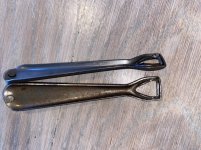
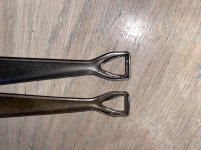
Frysk
Member
Thanks Pwcosol and AntoniFrysk,
I agree with pwcosol...your Mundlos 1940 HKW appears to actually be an original late Hawig flat tool (4th model).
Remember that the "serrations" on the HKW had a function and remained unaltered until around late 1942.
Antoni



